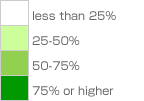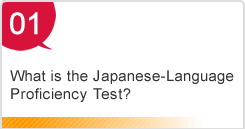The list summarizes "what successful JLPT examinees of each level think they can do in Japanese," based on self-evaluation survey results.
It is not a syllabus (question outline) of the JLPT, nor does it guarantee the Japanese-language proficiency of successful examinees. For language proficiency measured by the JLPT and question outline, please refer to "Summary of Linguistic Competence Required for Each Level."
The list can be used as a reference to help examinees and others get an idea of "what successful examinees of a particular level can do in Japanese."
※Please use "PDF for printout" when making hard copies, as the line height of tables varies by computer and character display size.
| N1 | N2 | N3 | N4 | N5 | |||
| 1 | I can understand the main points of articles on politics, economics, etc., in newspapers and magazines. | ||||||
| 2 | I can understand the points, opinions, and argument structure of editorial columns (e.g. in newspapers, etc.). | ||||||
| 3 | I can read novels, understanding the feelings of the characters and the story line. | ||||||
| 4 | I can understand what the author wants to say in narrative essays. | ||||||
| 5 | I can understand the main ideas of academic/technical texts on topics I am concerned about. | ||||||
| 6 | I can understand the content of official letters and e-mails written in polite Japanese. | ||||||
| 7 | I can understand inquiries and requests from business partners. | ||||||
| 8 | I can understand the content of articles in newspapers and magazines written about familiar everyday topics. | ||||||
| 9 | I can get necessary information from travel guidebooks and magazines about entering university or finding jobs. | ||||||
| 10 | I can understand the definitions provided in general Japanese-Japanese dictionaries. | ||||||
| 11 | I can get necessary information from the brochures of products (e.g. product features, etc.). | ||||||
| 12 | I can understand the main story lines of short stories. | ||||||
| 13 | I can understand post cards and e-mails from my acquaintances and friends. | ||||||
| 14 | I can get necessary information (e.g. lecture or meeting schedules, etc.) from notice boards at school or work. | ||||||
| 15 | I can understand the sale dates and prices listed in newspaper advertisements and fliers. | ||||||
| 16 | I can read train schedules and guide signs at stations in order to determine what time to board my train. | ||||||
| 17 | I can read and understand New Year's and birthday cards. | ||||||
| 18 | I can understand simple memos. | ||||||
| 19 | I can understand simple instructions with pictures (e.g. how to put out trash, how to prepare meals). | ||||||
| 20 | I can understand my appointment day and time from appointment reservation charts at my school, etc. |
※Percentages of successful examinees of each level who think they "can do" an item are shown in four ranges. When estimating percentages, the responses of only "successful examinees near the passing line" were used. For details, please refer to "2.List preparation" at the beginning.

JLPT Can-do Self-Evaluation List

-
- *Outside Japan, the test may be held only in July or December in some cities. Click here for the test schedule in your city.
End of Text










